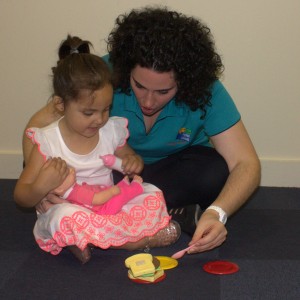 Last week we looked at how pretend play begins in toddlers. Now we will look at how it develops further, with more complexity in three year olds.
Last week we looked at how pretend play begins in toddlers. Now we will look at how it develops further, with more complexity in three year olds.
By three years preschoolers begin to combine actions and objects to act out scenes. As they move towards four years they learn to use a mixture of people, real objects and imaginary objects to act out sequences of actions. They act out themes that they see in their daily life around the home and later outside the home as well such as such as a caring for babies, cooking or going to the petrol station. Play scenes are based on things that the child has experienced before, though they begin to explore things outside of the home, that happen less often such as shopping and doctors.
Here are some fun ideas for pretend play for three year olds:
1. Dress ups are a cheap and fun way to pretend. Try op- shops for some real bargains or make your own dress ups. As well as interesting clothes, look for belts, hats, scarves, shoes, handbags, wallets, sunglasses and cloths that can be used for capes. You can also add extras like hats and pretend jewelry. Your child will love to dress up in your shoes, sunglasses and handbags and pretend to be an “adult” so check the back of your wardrobe and you may not need to spend anything at all for a fun afternoon.
2. Cubbies are great for developing pretend play skills. Cubbies don’t have to be a house. They can also be a shop, a cafe’, a post office, a doctor’s surgery, a pet shop, a vet surgery or whatever captures your child’s interest. All you really need is an enclosed space, such as a large cardboard box (try asking a shop that sells furniture or white goods if they have one to spare) or a blanket, sheet or tarp spread over some chairs, a table or a clothes airer. You can buy cheap pop up tents in toy shops and “cheap shops” that are portable, easy to put away and can be used over and over inside and outside for a wide range of activities.
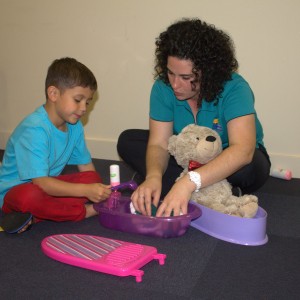 3. Play shops. You can set up a shop in a cubby or just use a children’s table or coffee table as a counter. You can use empty packages or even full ones from your kitchen cupboard as stock for your shop. You can add plastic fruit and vegetables or play food from cheap shops too. Help your child to arrange their “stock” talking about sizes, which boxes are big, small, heavy, light, wide, narrow, tall or short. You can arrange them in order and talk about comparatives “big, bigger, biggest”. You can also practice sorting foods into different types using describing words and categories. You can use a box to make a cash register or you can buy pretend ones in toy shops. You can also buy play money or you can make your own. Put some numbers on paper and attach to your groceries to make price tickets. Use social skills to request things, ask for information, use please, excuse me and thank you and give help.
3. Play shops. You can set up a shop in a cubby or just use a children’s table or coffee table as a counter. You can use empty packages or even full ones from your kitchen cupboard as stock for your shop. You can add plastic fruit and vegetables or play food from cheap shops too. Help your child to arrange their “stock” talking about sizes, which boxes are big, small, heavy, light, wide, narrow, tall or short. You can arrange them in order and talk about comparatives “big, bigger, biggest”. You can also practice sorting foods into different types using describing words and categories. You can use a box to make a cash register or you can buy pretend ones in toy shops. You can also buy play money or you can make your own. Put some numbers on paper and attach to your groceries to make price tickets. Use social skills to request things, ask for information, use please, excuse me and thank you and give help.
4. Play dough is a cheap, flexible play activity that lends itself to all kinds of pretending. It works well to extend play with tea sets and cooking utensils. You can also use it to feed plastic animals, or carry in toy trucks. A flat base of play dough is great for making a base for a mini world, as trees, animals and fences will stand up better. There are lots of different recipes for making your own play dough with different colours textures and even scents. These are cheap and so can be replaced when needed.
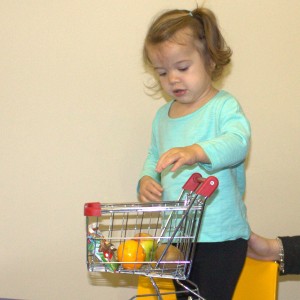 5. Vehicles are always popular. You can buy a mat with roads for smaller vehicles or draw your own on a large sheet of cardboard or use chalk on the ground outside. Put train sets and cars together for more complex play and add some plastic animals or figurines.
5. Vehicles are always popular. You can buy a mat with roads for smaller vehicles or draw your own on a large sheet of cardboard or use chalk on the ground outside. Put train sets and cars together for more complex play and add some plastic animals or figurines.
6. Sand and water play allows for lots of different themes such as cooking, bathing dolls or gardening.
7. Dolls houses allow for lots of different types of role play. Add animals and plastic or wooden people to expand the options.
8. Blocks are great for all kinds of things, but in terms of pretending they work best when animals, cars or toy people are added to expand the possibilities.
9. Cardboard and boxes can be just about anything. Small boxes can be used to set up a pretend shop, larger ones can be a car, bus or train and very large ones can be a cubby. Help your child draw details on the boxes and cut out doors or windows for them. Add some soft toys to join in the play.
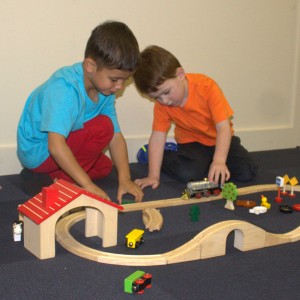 10. Families. Kids love to pretend to be the adults in their life. Let them dress up in some of your clothes and shoes and do the things they see you do everyday. Maybe they could pretend to do the things they think you do at work too. This can be an fascinating way to see how your child views your world.
10. Families. Kids love to pretend to be the adults in their life. Let them dress up in some of your clothes and shoes and do the things they see you do everyday. Maybe they could pretend to do the things they think you do at work too. This can be an fascinating way to see how your child views your world.
11. Food play allows for all kinds of themes around cooking and picnics. You can use plastic play food, real food, empty food packages or playdough. You can use a tea set or real items from the kitchen. Include some "friends" such as teddies and get some conversation going about likes and dislikes, tastes and textures, procedures for cooking, serving, eating and cleaning up. You can expand into more complex themes of cafes or restaurants.
12. Housework. Preschool kids also love to pretend to do cleaning and things they see you do around the house. You can get miniature play items to use, use the real thing or build your own pretend items. Let them play alongside you as you do the washing and then dishes and even join in on the real thing. Enjoy this stage, it won't last.
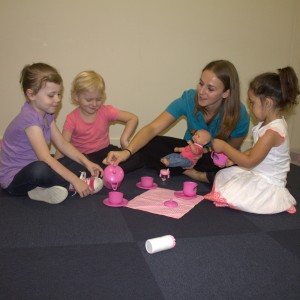 Next week see how play expands into fantasy themes in four and five year olds.
Next week see how play expands into fantasy themes in four and five year olds.
If you are concerned about your child's development including play skills, communication skills, social skills or learning check our website to see how Talking Matters may be able to help. For more ideas and resources check the resources section on our website and our extensive Pinterest page. Like us on Facebook and follow us on Twitter so you don't miss out on what's happening.
Talking Matters provides speech pathology, occupational therapy and psychology services for children. To find out more about Talking Matters and our services and resources check our website or call our office on (08) 8255 7137.
Jo Brenecki
Related Blog Posts
If you liked this post you may also like:
Using TIC-TAC-TOE To Grow
6 ways to help your high school student be organised for school
A Mum's ASD tips
OT at School



